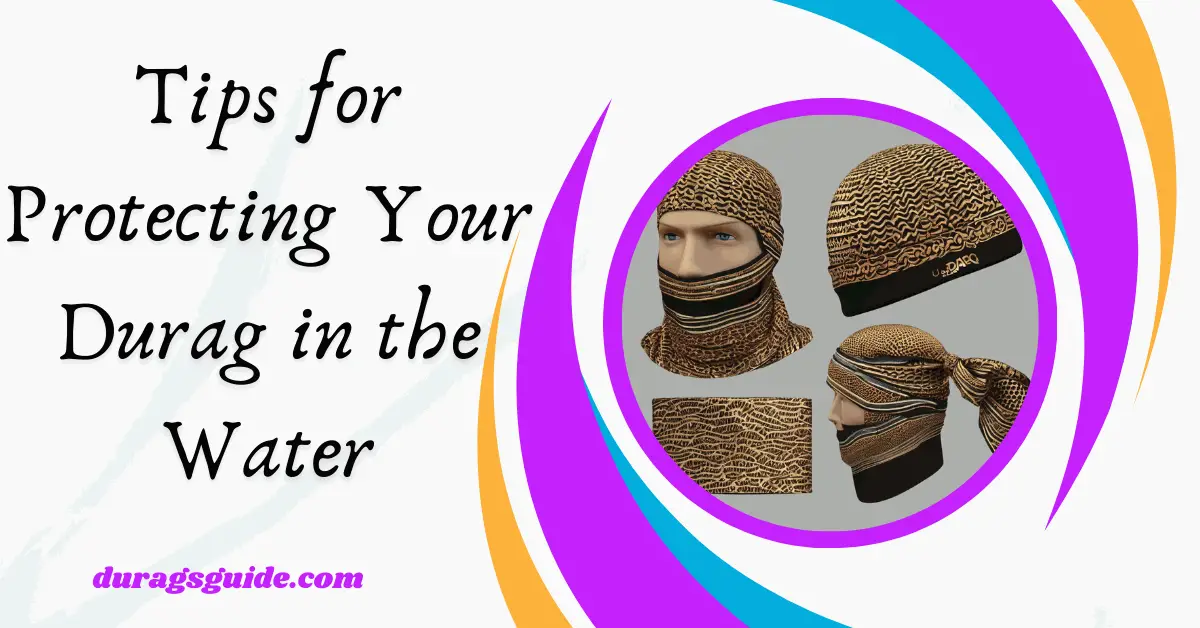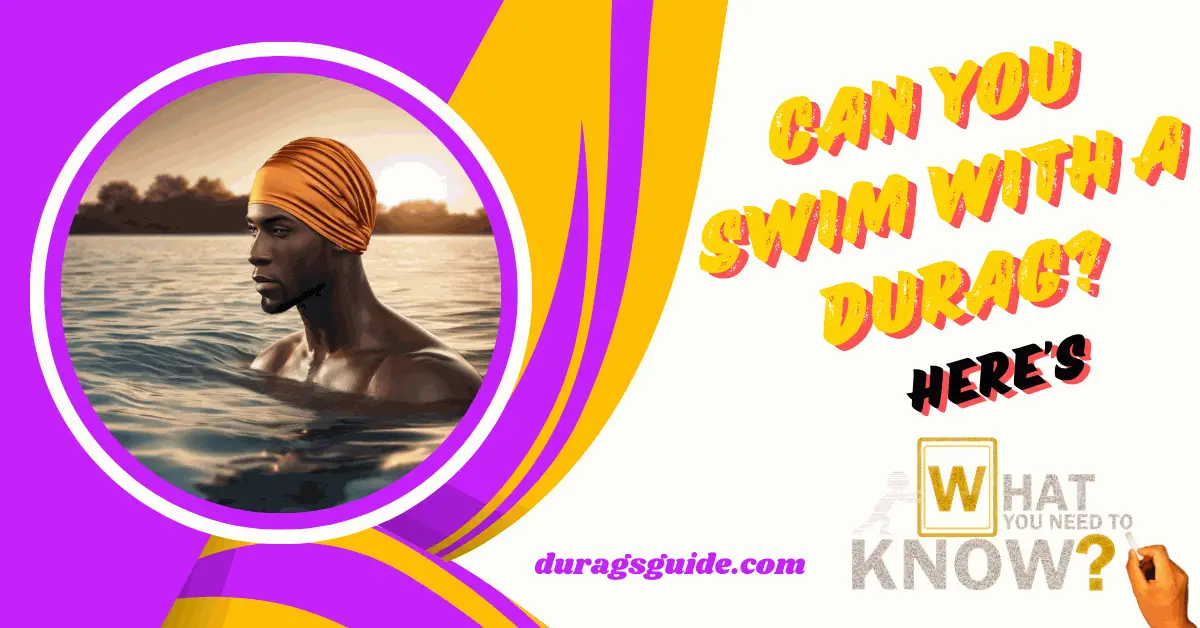Can You Swim with a Durag?
In this sections, we will delve deeper into the topic of swimming with a durag. We will explore the potential risks, necessary precautions, alternative options, and the importance of proper hair care before and after swimming. So let’s dive in and discover whether swimming with a durag is a viable option or if there are better alternatives to consider. And here we also know whether drugs are waterproof or not.
The Impact of Water on Durags
When it comes to durags, it’s essential to understand how water can affect them. Water, especially when submerged for an extended period, can have both positive and negative effects on durags and the hair beneath them.
On one hand, water can help moisturize the hair and promote hydration. It can soften the hair, making it more manageable and easier to style. This can be particularly beneficial for individuals with dry or brittle hair, as water can provide a much-needed boost of moisture.
However, prolonged exposure to water can also pose challenges for durags and the hair they protect. When submerged, the fabric of the durag can become saturated, leading to potential stretching or damage. This is especially true for durags made of materials like cotton, which tend to absorb water more easily.
Additionally, the weight of the water-soaked durag can cause it to slip or become dislodged, potentially exposing the hair to the elements. This can result in frizz, tangles, and even breakage, defeating the purpose of wearing a durag in the first place.
It’s important to note that the impact of water on durags can vary depending on the specific material, quality, and construction of the durag. Silk or satin durags tend to fare better in water as they are less absorbent and provide a smoother surface for the hair. However, even with these materials, precautions should still be taken to ensure the durag remains intact and the hair protected.

Can You Safely Swim with a Durag?
Swimming with a durag is a topic that sparks curiosity among many individuals who wear durags. While it’s possible to swim with a durag, there are certain considerations and precautions to keep in mind to ensure both the durag and your hair remain protected.
One of the primary concerns when swimming with a durag is the possibility of the durag coming off or shifting during water activities. This can be especially true for loose-fitting durags or those made of absorbent materials. To minimize the risk of displacement, opt for a durag that fits securely and snugly around your head. Consider using a double-tied method or using additional accessories like bobby pins or clips to keep the durag in place.
Another important aspect to consider is the type of water you’ll be swimming in. Chlorinated pools, saltwater, and even freshwater bodies can all have different effects on both the durag and your hair. Chlorine and salt can be drying to the hair, potentially causing damage and frizz. It’s crucial to rinse your hair and durag thoroughly with clean water after swimming to remove any residual chemicals or salt.
Additionally, it’s essential to be mindful of the durag’s material when swimming. Silk or satin durags tend to be more resilient in water as they are less absorbent and provide a smoother surface for your hair. Cotton durags, on the other hand, can become heavy and stretched when wet, leading to potential discomfort and hair damage. While swimming with a durag is possible, it’s important to assess your individual circumstances and preferences.

Potential Risks and Challenges of Swimming with a Durag
While swimming with a durag is possible, it’s crucial to be aware of the potential risks and challenges that may arise. By understanding these factors, you can make an informed decision about whether swimming with a durag is the right choice for you.
One of the primary risks of swimming with a durag is the potential for it to become dislodged or displaced in the water. The force of the water and the movement of swimming can cause the durag to shift or even come off completely, leaving your hair exposed and vulnerable. This can result in tangles, frizz, and potential damage to your hairstyle.
Another challenge is the potential damage to the durag itself. Submerging the durag in water for an extended period can cause it to become saturated and heavy, leading to stretching or even tearing of the fabric. This can shorten the lifespan of your durag and require more frequent replacements.
Additionally, if you swim in chlorinated pools or saltwater, the chemicals or salt can have drying effects on both the durag and your hair. Chlorine, in particular, can strip the hair of its natural oils, causing it to become dry, brittle, and prone to breakage. Saltwater can have similar effects, leaving your hair feeling coarse and dehydrated.
Considering these risks and challenges, it’s important to evaluate whether swimming with a durag is worth it for you. If you decide to proceed, taking preventive measures such as securing the durag tightly, using additional accessories like bobby pins, and rinsing your hair and durag thoroughly after swimming can help minimize the potential negative effects.

Tips for Protecting Your Durag in the Water
If you choose to swim with a durag, it’s important to take certain precautions to protect both the durag itself and your hair. By following these tips, you can minimize the risks and challenges associated with swimming while wearing a durag.
- Secure the durag properly: Ensure that the durag is tied securely and snugly around your head. Use a double-tied method or consider using additional accessories like bobby pins or clips to keep it in place.
- Choose the right material: Opt for a durag made of silk or satin, as these materials are less absorbent and provide a smoother surface for your hair. They are less likely to become heavy and stretched when exposed to water.
- Avoid excessive water exposure: Limit the amount of time you spend in the water while wearing a durag. Prolonged exposure to water can increase the risk of the durag becoming saturated and potentially causing damage to both the durag and your hair.
- Rinse with clean water: After swimming, rinse your hair and durag thoroughly with clean water to remove any chlorine, salt, or other chemicals. This will help prevent drying and minimize potential damage.
- Pat dry gently: Instead of vigorously rubbing your hair with a towel, gently pat it dry to avoid excessive friction and potential damage to your hairstyle. Be careful not to disturb the durag or the hair beneath it.
- Consider alternative hair protection: If you’re concerned about the risks and challenges of swimming with a durag, explore alternative options for hair protection. Swim caps made of materials specifically designed for swimming can provide effective hair care and protection.

Durag Maintenance After Swimming
Proper durag maintenance is crucial after swimming to ensure its longevity and keep your hair protected. By following these maintenance tips, you can prolong the lifespan of your durag and maintain healthy hair.
- Wash the durag: After swimming, it’s important to wash your durag to remove any residue or chemicals that may have accumulated. Follow the care instructions provided by the manufacturer to ensure you wash it correctly. Using a gentle detergent and cold water is usually recommended.
- Air dry the durag: Allow the durag to air dry naturally after washing. Avoid using a dryer or exposing it to direct heat sources, as this can damage the fabric and affect its shape.
- Store the durag properly: When not in use, store your durag in a clean and dry place. Avoid folding it too tightly, as this can cause creases and affect its fit. Consider investing in a durag storage case or using a clean, dedicated drawer for durag storage.
- Inspect for damage: Regularly inspect your durag for any signs of damage, such as loose threads or tears. If you notice any issues, consider replacing the durag to ensure optimal hair protection.
- Maintain good hair care: In addition to durag maintenance, it’s essential to continue practicing good hair care habits. This includes regular washing, conditioning, and moisturizing your hair to keep it healthy and minimize breakage.

Alternative Hair Protection Options for Swimming
If you’re concerned about the risks and challenges of swimming with a durag, there are alternative options available to protect your hair while enjoying water activities. These options provide effective hair care and minimize the potential negative effects associated with swimming.
- Swim caps: Swim caps are specifically designed for swimming and can provide excellent hair protection. They create a barrier between your hair and the water, reducing the exposure to chlorine, salt, and other chemicals. Look for swim caps made of materials like silicone or latex, as they offer better durability and water resistance.
- Protective hairstyles: Consider styling your hair in protective hairstyles before swimming. Braids, twists, buns, or even wearing your hair in a high ponytail can help minimize exposure to water and reduce the risk of tangles, frizz, and breakage.
- Waterproof hair products: Prior to swimming, apply a waterproof hair product, such as a leave-in conditioner, oil, or serum, to create a protective barrier for your hair. These products can help seal in moisture and minimize the drying effects of water and chemicals.
- Pre-swim rinse: Before entering the water, thoroughly wet your hair with clean water. This can help reduce the absorption of chlorine or saltwater, as hair tends to absorb less water when it’s already saturated.
- Post-swim hair care: After swimming, rinse your hair with clean water to remove any chlorine or salt residue. Follow up with a moisturizing conditioner to replenish lost moisture and keep your hair hydrated.

Final Thoughts
In conclusion, swimming with a durag is possible, but it comes with potential risks and challenges. While the durag can provide some hair protection, it may become displaced or damaged in the water, and your hair may still be exposed to drying chemicals. However, by taking precautions such as securing the durag properly and rinsing thoroughly after swimming, you can minimize these risks. Alternatively, exploring alternative options like swim caps or protective hairstyles can provide effective hair protection while swimming. Ultimately, the decision to swim with a durag or choose an alternative method depends on your individual circumstances and preferences. Prioritizing hair health and using the appropriate protective measures will help ensure both your durag and your hair remain in good condition.
FAQS
Do you need to wear a waterproof cap on top of your durag when swimming?
It is not necessary to wear a waterproof cap on top of your durag when swimming. You can simply let your durag dry after swimming.
Can you shower with a durag on?
Some people believe that showering with a durag on has its benefits, while others think it's not necessary. It is a personal preference.
Does wearing a durag lock in moisture?
Yes, wearing a durag can help lock in moisture, keeping your hair moisturized and maintaining your 360 waves .
Should you rinse off your durag after showering or swimming?
It is recommended to rinse off your durag after showering or swimming to keep it clean and free from any product build-up.
Can swimming with a durag ruin your hair?
Swimming with a durag on can help protect your hair from chlorine damage, but it is important to wash and style your hair properly afterward to maintain its health.
